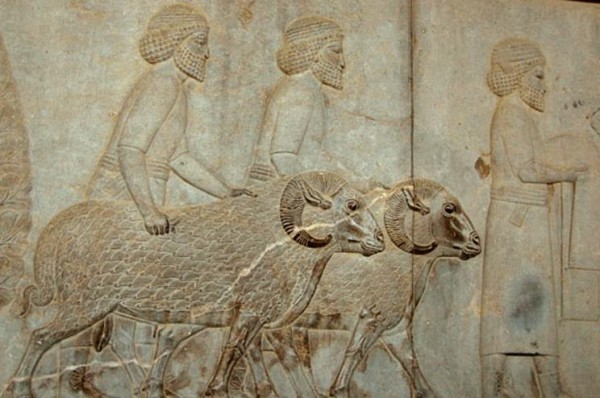
Assyrian delegation offering tribute to the Persian king in Apadana (modern-day Perspolis, Iran) 5th century BC
Courtesy of Wikipedia
The Neo-Assyrian Empire collapsed under the invasion of Iranian peoples in coalition with the Babylonians, Scythians and Cimmerians, in the late 7th century BC, culminating in the Battle of Nineveh (612 BC). Assyria had fallen completely by 608 BC. Between 612 and 559 BC, Assyria was divided between the Median Empire to the east and the Neo-Babylonian Empire to the west. Both parts were subsumed into the Achaemenid Empire in 539 BC and it has been argued they constituted the satrapies of Media and Babylonia, respectively, in Herodotus' account corresponding to the Ninth District. In the account the Ninth Tributary District comprised "Babylonia and the rest of Assyria", and excluded Eber-Nari.
It mostly incorporated the original Assyrian homeland in the upper Tigris, the middle and upper Euphrates, modern-day Syria (Eber-Nari) and part of south-east Turkey.
Despite a few rebellions, Assyria functioned as an important part of the Achaemenid Empire. The Assyrian
people were given the right to govern themselves throughout Achaemenid
rule, and the Assyrian (Aramaic) language was used diplomatically by the
Persians. Known for their combat skills, Assyrian soldiers (along with the Lydians) constituted the main heavy infantry of the Achaemenid empire's military.
Due to the major destruction of Assyria during the fall of its empire,
some scholars describe the area as an "uninhabited wasteland." Other Assyriologists,
however, such as John Curtis and Simo Parpola, have strongly disputed
this claim, citing how Assyria would eventually become one of the
wealthiest regions among the Achaemenid Empire. This wealth was due to the land's great prosperity for agriculture
that the Persians used effectively for almost 200 years. In contrast to
the policy of the Assyrian Empire, the Achaemenid Persians did not
intervene in the internal affairs of their ruling satrapies as long as
they continued the flow of tribute and taxes back to Persia.
Inhabitance at the former major Assyrian capitals was sparse during the
Achaemenid rule. Assyrian settlement were mostly in small villages at
plain level or on mounds such as Tell ed-Darim. However according to
some Assyriologists such as Georges Roux, a few cities such as Arrapkha
remained intact. Despite most of the Assyrian land was left in ruins
from the battles that led to the fall of its empire in the previous century, rural Assyria was prosperous according to the Greek scholar Xenophon.
Prior to the Persian rule of Assyria, The Achaemenids were greatly Assyrianized, and Aramaic continued as the lingua franca of the Empire in the region, with the Assyrian script
being the everyday writing system. Assyrian (Sumero-Akkadian) religion
within the empire were tolerated, and the judicial system, calendar and imperial standards imposed by the Assyrians remained in force everywhere.
The Assyrians,
like all other tributary peoples of the Persian Empire, were obliged to
pay taxes to the King of Persia and, whenever the King campaigned,
supply troops as well. Reliefs of Assyrian tribute bearers carved on the
east and north sides of the Apadana, consist of seven bearded men: one
carrying animal skins, one carrying a length of cloth, two carrying bowls, and two leading Mouflons.
In the late 4th century BC Alexander the Great
led his Greco-Macedonian army to conquer the Achaemenid Empire. The
empire's vast territory and numerous tributary peoples ensured that
rebellion would be a constant problem. This new Greek Empire relied upon
the administrative system put in place by the Persians to govern these
new lands; consequently, the Assyrian
lands of Athura and Mada were administrated as such by their own
Satraps. When Alexander the Great died, the Greek successor state of the
Seleucid Empire, created in the struggle over Babylonia, retained control of much of the Persian Empire. The Babylonian Chronicles of the Hellenistic Period now show the vitality of Greek culture in ancient cities like Babylon.
|